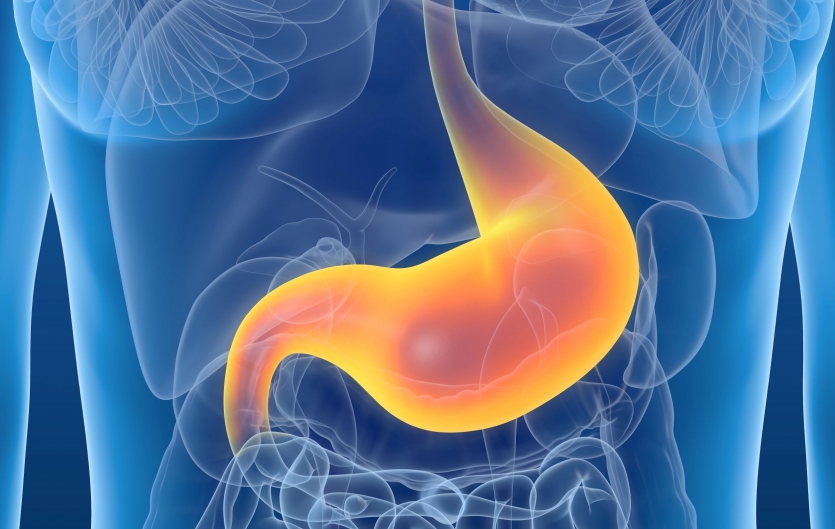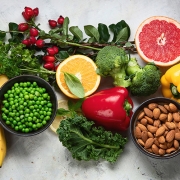Something to Digest—How Your Stomach Functions

Eating is one of life’s great joys. But what follows—digestion—is more work than wonder for your stomach. The stomach functions as a chemical and mechanical pouch solely designed to break down food for absorption. In addition to what the stomach does for digestion, it’s also your main food storage tank.
The stomach is also the first stop after you’ve swallowed food. Unlike other sophisticated organs, like the brain or liver, the stomach is a physical brute. In addition to a muscular lining to pulverize food into smaller pieces, highly acidic gastric juices are created to further dissolve your dinner. What the stomach does is tackle the tough work of preparing nutrients to be absorbed in the intestines.
Your stomach anatomy is unique, which helps it perform three vital food functions:
- Temporary storage
- Mixing and breakdown
- Preparation for nutrient absorption in the intestines
Read on to learn more about how the stomach functions. You’ll also discover the way vitamin B12 and other nutrients are extracted from food, fun stomach facts, and how to care for your digestive system.
Your Stomach Anatomy Helps Accomplish What the Stomach Does in Digestion
The entire digestive system is one continuous tube connecting your mouth (where food enters) to your anus (where waste is expelled). And your stomach anatomy is best described as an enlarged, pouch-like section of this digestive tube. The muscular, J-shaped organ is found in the upper part of your abdomen on the left side of your torso. At approximately 12 inches long and six inches wide—size may vary depending on the person, sex, build, and how much they’ve eaten—it connects your esophagus to your small intestine.
All digestion starts in your mouth, where food is chewed and combined with saliva. As each bite is sufficiently broken down, a digestive tube opens at the esophagus to allow food to travel to the tip of your stomach. Once there, an esophageal sphincter opens to pass chewed food into the stomach—one of the many key organs for extracting nutrients from your diet. If the sphincter doesn’t work properly, acidic gastric juices can leach into your esophagus which feels unpleasant—to say the least.
Your stomach anatomy is broken into four primary sections:
- Cardia: Where contents of the esophagus enter the stomach.
- Fundus: An expanded area connecting the esophagus to the stomach.
- Body: The main, central region of the stomach.
- Pylorus: Where digested food is dispelled into the small intestine.
The majority of what the stomach does for food digestion takes place in the organ’s body section, where chewed foods mix with acidic gastric juice and digestive enzymes. This content is churned through a series of muscle contractions called peristalsis. They are vigorous enough to ground solid foods down into a smooth food pulp for easy extraction of nutrients in the intestines.
The inner mucous lining of the stomach contains a series of folds that run its length—from the esophageal to the pyloric sphincters. These folds aid stomach functions by creating pathways for moving the food around and helping in digestion. While the majority of nutrient absorption takes place in your small intestine, the stomach does pull out some water, medication, amino acids, and water-soluble vitamins during its digestive stage.
Your stomach wall is made up of several layers of mucous membrane, connective tissue with blood vessels, nerves, and muscle fibers. Inner stomach lining also has glands that release the three to four liters of gastric juice needed every day to facilitate the absorption of nutrients. Its hydrochloric acid also breaks down food while digestive enzymes split up proteins.
Gastric juice is so virulent to organic matter it’s able to kill bacteria in your digestive system. To protect your stomach from the gastric juices, bicarbonate is produced in the pancreas and the stomach to neutralize the hydrochloric acid. In addition, mucus lines the walls of the stomach to reduce the effects of gastric juices. Once food has been transformed into pulp, the pyloric sphincter opens and pushes the material into your small intestine for further digestion and nutrient absorption. The stomach’s digestive job is done.
The Stomach Functions as a Key Cog in Vitamin B12 Absorption
Vitamin B12 is an important nutrient to keep your body’s nerve and blood cells healthy, while helping support DNA synthesis and red-blood-cell formation. Good sources of B12 are readily available in meats (beef, pork, and fish), eggs, milk, and fortified cereals. B12 is so vital to your body that three to five years’ worth of the essential vitamin is stored in your liver to continue healthy red-blood-cell production and other key functions.
While B12 is primarily absorbed in the small intestine, it can’t be used without first passing through the stomach. During the initial digestion process, B12 is pulled out of food and combined with a cell-recognition protein, called an intrinsic factor, from the parietal cells of the stomach.
Vitamin B12 supports the health of your entire body. This essential vitamin helps keep the body’s nerves and blood cells healthy and helps maintain the mechanisms for making new DNA. And without the digestive assistance from the stomach, the body wouldn’t be able to take on this vital nutrient.
Tips on How to Care for Your Stomach
You’ve learned how the stomach functions. Now let’s explore how you can support optimal stomach health. Caring for your stomach can have overlapping benefits for the rest of your body. And simple lifestyle changes go a long way to promote good stomach health and support your general well-being.
- Stay Hydrated
Water is vital for good health, and it is essential at all levels of digestion. Water helps soften food as you chew it, assists with its travel down the esophagus, and creates bulkier yet softer stool for waste removal. Water also aids in the breakdown of foods so your body can absorb the nutrients. Drinking eight glasses of water a day helps your stomach process food and supports proper hydration.
- Follow a Regular Eating Schedule
When you eat is almost as important as what you eat. Your body’s circadian clock is an internal biologic timer that coordinates daily behaviors: sleep/wake, hormone release, and heart function. It responds to environmental changes, like light and food, and helps coordinate your circadian rhythms with your surroundings.
When your clock is out of sync, it can negatively affect your health. Your body expects certain fuels (fats, sugars) at specific times of day. Eating at set times allows for proper digestion. Sporadic eating overworks your stomach as it digests food, sometimes causing bloating and indigestion. Studies show eating every 3–5 hours gives your stomach enough time to adequately process your food and fuel your body.
- Eat More Fiber
Fiber is a unique type of carbohydrate that’s essential to maintain a healthy weight and support overall health. While most carbohydrates are converted into sugar, fiber passes through your body undigested. It helps to regulate your hunger levels and assists with waste removal, supporting digestive health and overall well-being.
There are two types of fiber: soluble and insoluble. Soluble fibers are found in oats, peas, beans, carrots, and citrus fruits. Insoluble fibers—wheat bran, nuts, and certain vegetables like cauliflower and potatoes—don’t dissolve in water to help materials move through your digestive tract.
Your stomach muscles and gastric acids break down food. And a diet rich in fiber helps bind the food pulp that’s passed from the stomach into the intestines. Once it reaches your colon, fiber feeds friendly gut bacteria and helps maintain your microbiome.
- Chew Your Food
Food is mostly digested in your stomach and intestines, but the process starts the second you take a bite. Chewing breaks down food into smaller pieces. This helps food to travel down your esophagus (to avoid choking) and assists your stomach with digestion. Chewing mixes saliva—which is packed with digestive enzymes—into your food to allow your body to absorb the greatest amount of nutrients.
Properly chewed food is easier for your stomach to mix with enzymes and digestive juices to continue breaking down nutrients for fuel. The better you chew your food, the easier it is for your stomach functions to carry on optimally.
Did you know these fun stomach facts?
- Excuse me! Burping releases air molecules swallowed while eating. That’s why you burp when you drink carbonated beverages.
- Belly size doesn’t correlate to stomach size. Regardless of your midsection’s girth, the average stomach is the same size, about 12 inches long and six inches wide.
- On the front line. The acid in your stomach sterilizes and neutralizes bacteria and other toxins you might consume.
- Home of hormones. Your stomach produces a variety of substances. This includes digestive enzymes, acids, and hormones that help stimulate hunger.
- Stronger than steel. Stomach acid, or hydrochloric (HCl) acid, is powerful enough to dissolve most metals. Originally produced from green vitriol and rock salt, HCl is also known as muriatic acid, acidium salis, and spirit of salts.
- Time for supper. A growling stomach is called borborygmic. It happens all the time, but it’s easier to hear when your stomach is empty.
- Zero gravity diners. Muscles in your esophagus constrict and relax in a wave-like manner called peristalsis. This motion pushes food down your esophagus, which is why astronauts digest their food the same in space as on Earth.
Feed Your Body Right to Keep Up Healthy Stomach Function
It’s common for the stomach to be considered the home of your entire digestive process. But your stomach is just one of the many important organs that help your body absorb nutrients.
The best way to take care of your stomach’s health is to eat a balanced diet of whole foods, lean meats, plant-based fats, and to drink plenty of water. And while exercise doesn’t directly impact stomach functions, an active lifestyle can help burn excessive calories and help with heart health.
As the fuel tank for your body, your stomach temporarily stores the food that it later turns into the energy you need to power your life. So, the next time you feel something in the pit of your stomach, use these tips to give your belly the extra boost of support it needs.
References
https://www.ncbi.nlm.nih.gov/books/NBK279304/
https://www.niddk.nih.gov/health-information/digestive-diseases/digestive-system-how-it-works
https://medcraveonline.com/IJCAM/IJCAM-09-00318
https://ods.od.nih.gov/factsheets/VitaminB12-Consumer/
https://www.cancer.ca/en/cancer-information/cancer-type/stomach/stomach-cancer/the-stomach/
https://journals.sagepub.com/doi/full/10.1177/0748730419892105
https://www.healthline.com/health/probiotics-and-digestive-health
https://www.ncbi.nlm.nih.gov/pmc/articles/PMC1151822/
https://ods.od.nih.gov/factsheets/VitaminB12-HealthProfessional/
https://www.health.harvard.edu/staying-healthy/should-you-take-probiotics












